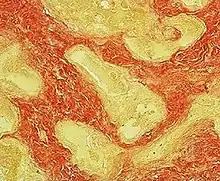
Van Gieson's stain in an angioleiomyoma, making smooth muscle fibers yellow and collagen fibers red.
.jpg.webp)
Hematoxylin and Van Gieson's stain gives collagen a pink color, such as in fibrosis (arrows, here in cirrhosis).
Van Gieson's stain is a mixture of picric acid and acid fuchsin. It is the simplest method of differential staining of collagen and other connective tissue. It was introduced to histology by American neuropsychiatrist and pathologist Ira Van Gieson.[1]
HvG stain generally refers to the combination of hematoxylin and Van Gieson's stain,[2] but can possibly refer to a combination of hibiscus extract-iron solution and Van Gieson's stain.[3]
Other dyes
Other dyes used in connection with Van Gieson staining include:
References
- ↑ Jocelyn H. Bruce-Gregorios, M.D.: Histopathologic Techniques, JMC Press Inc., Quezon City, Philippines, 1974. ISBN 971-11-0853-4, BAN CROFT, Mahendra Jain A.C.P.M Dental College India.
- ↑ Mair, T.S.; Sherlock, C.E.; Fews, D.; et al. (2016). "Idiopathic Fibrosis of the Tunica Muscularis of the Large Intestine in Five Horses with Colic" (PDF). Journal of Comparative Pathology. 154 (2–3): 231–234. doi:10.1016/j.jcpa.2016.01.001. hdl:1983/7e8f3f91-3fae-47f0-a9f0-5497d594aa46. ISSN 0021-9975. PMID 26852342.
- ↑ Benard SA, Afolabi OO, Fowotade AA, et al. (2017). "Hibiscus-Van Gieson Stain for collagen fibres". African Journal of Cellular Pathology.
This article is issued from Wikipedia. The text is licensed under Creative Commons - Attribution - Sharealike. Additional terms may apply for the media files.